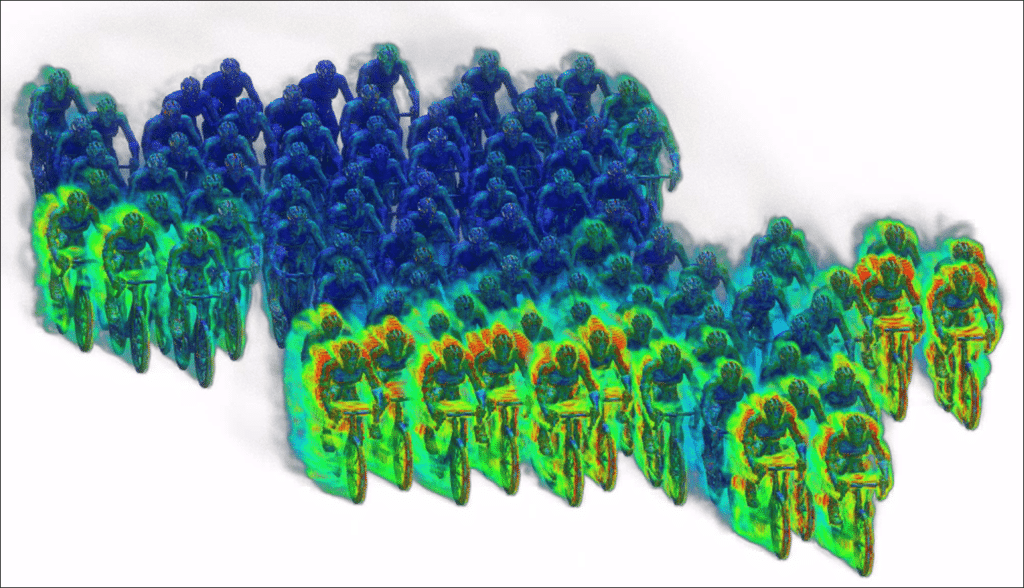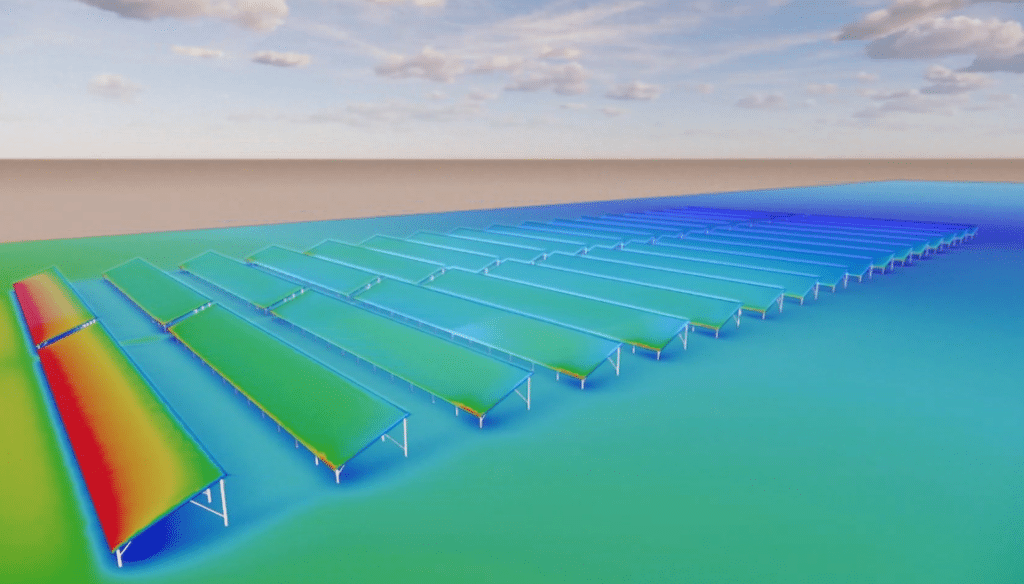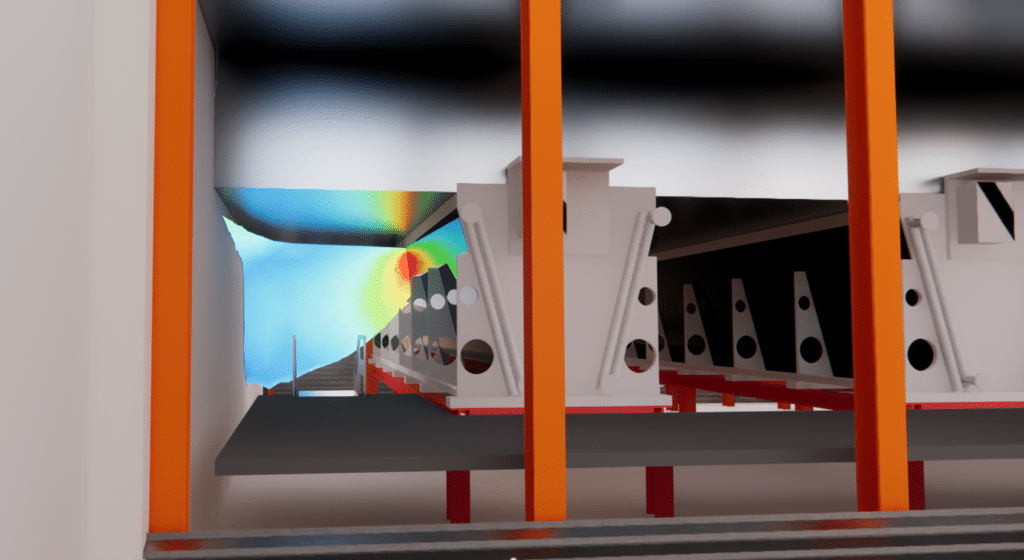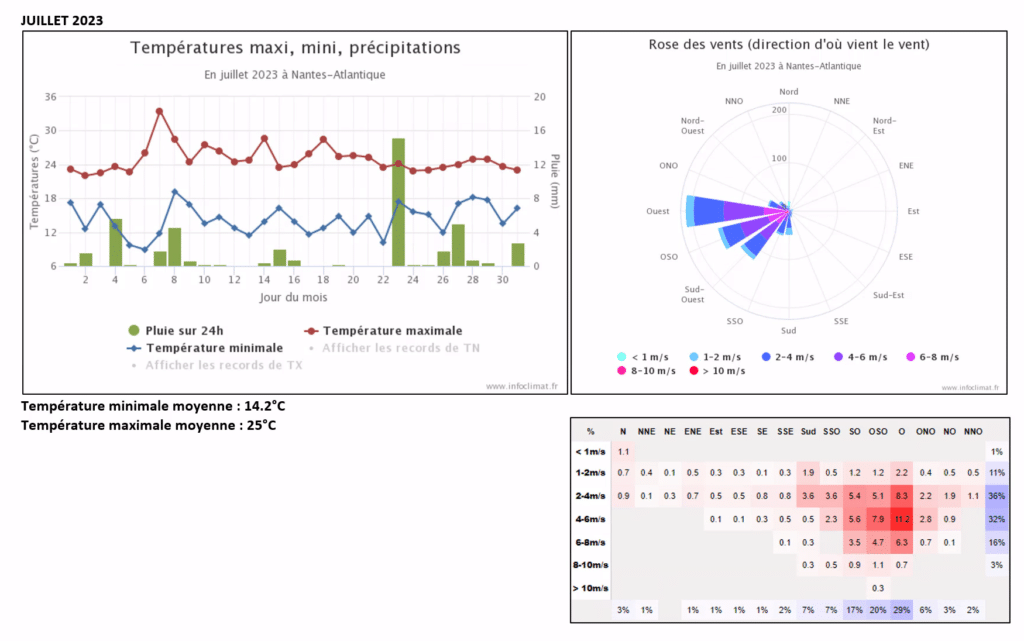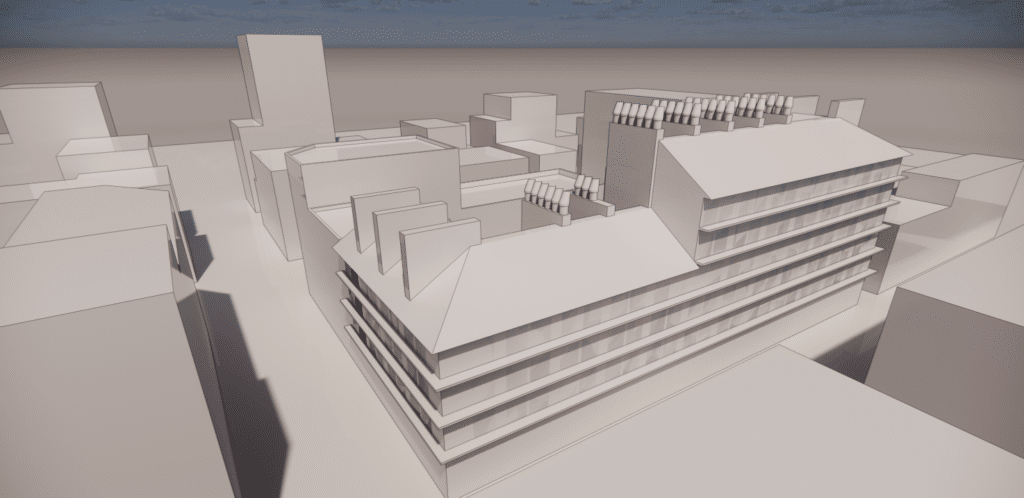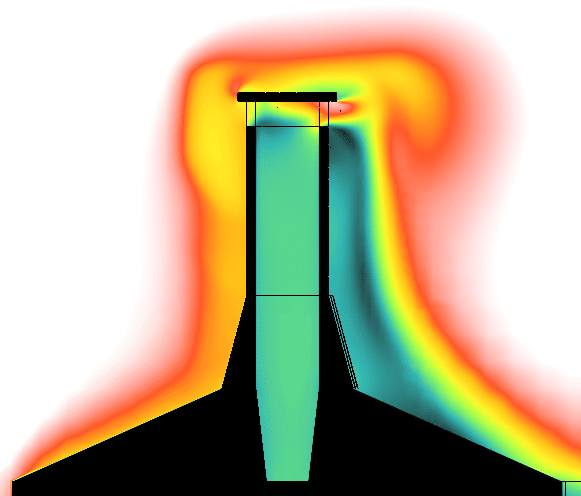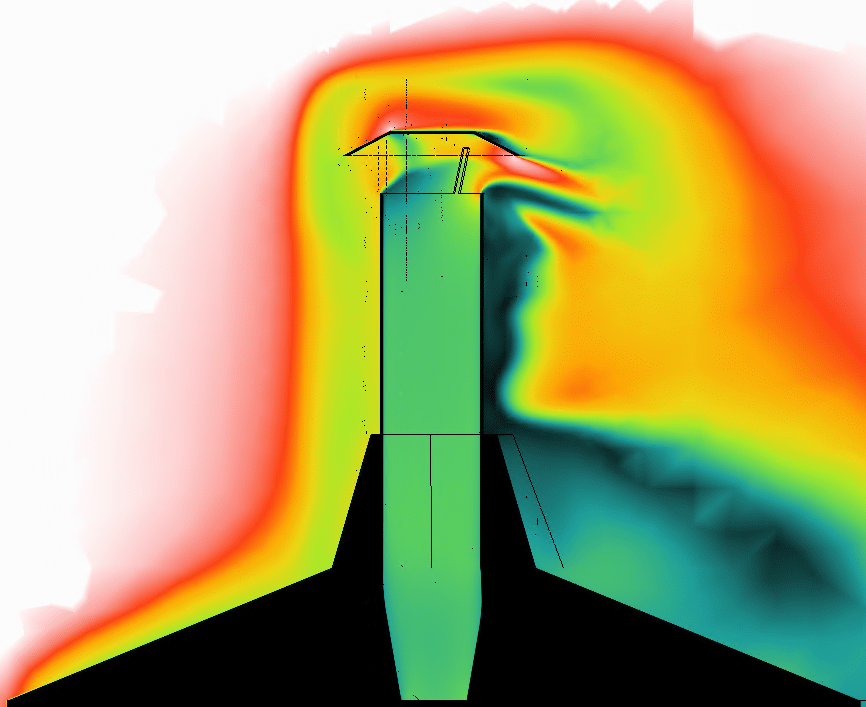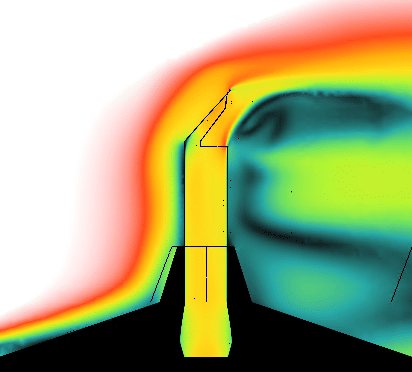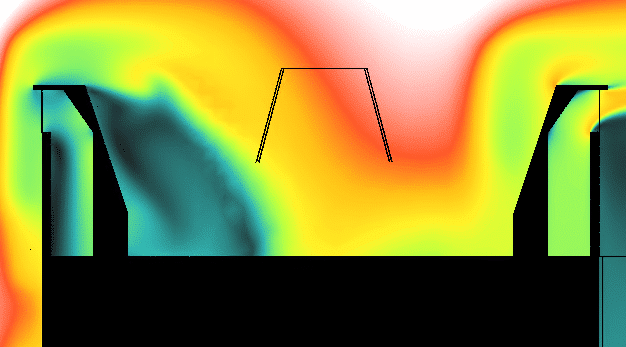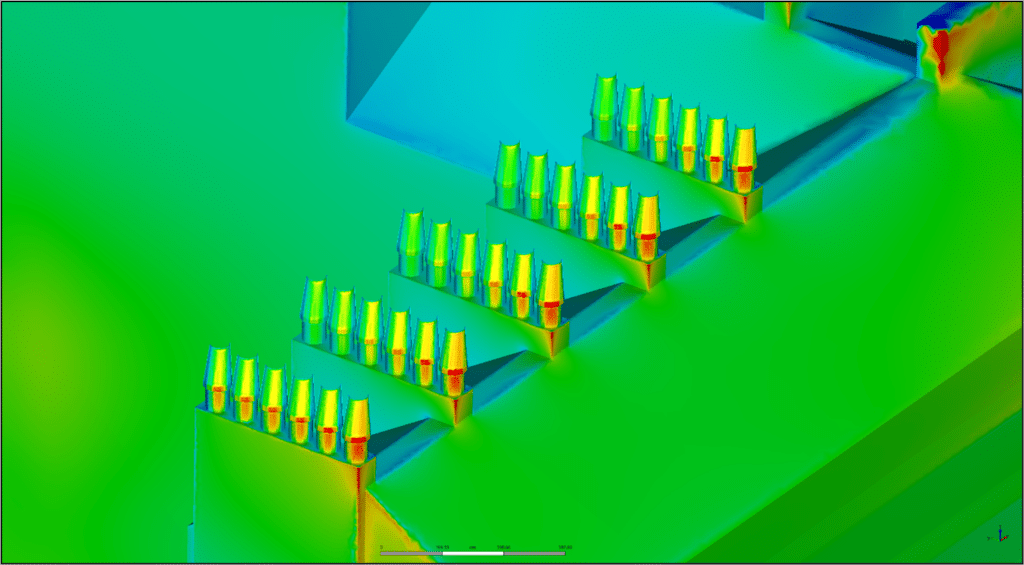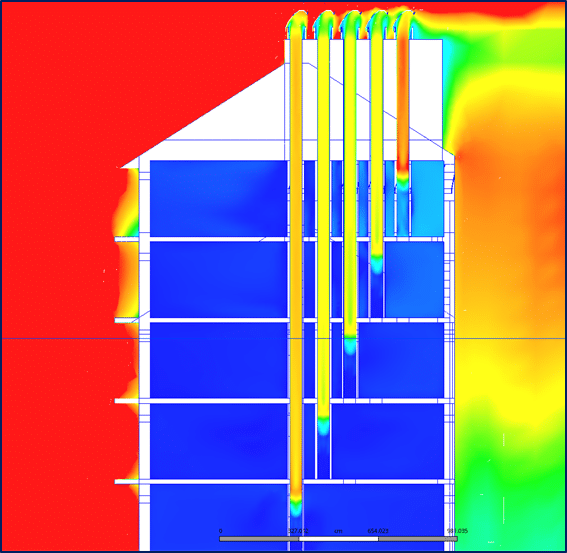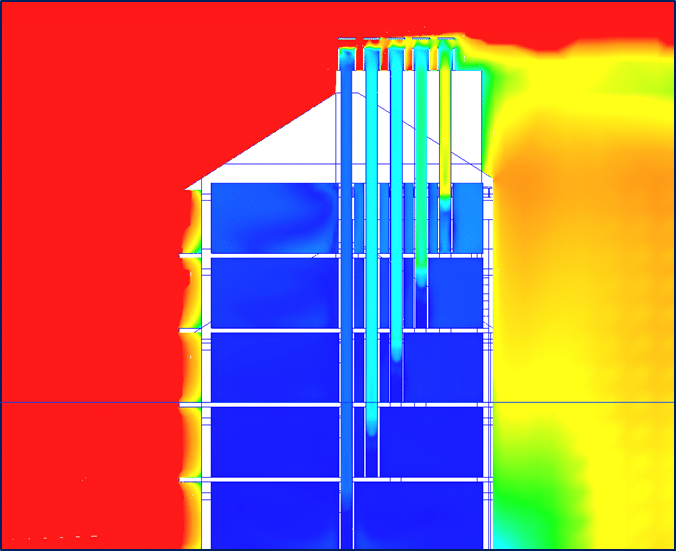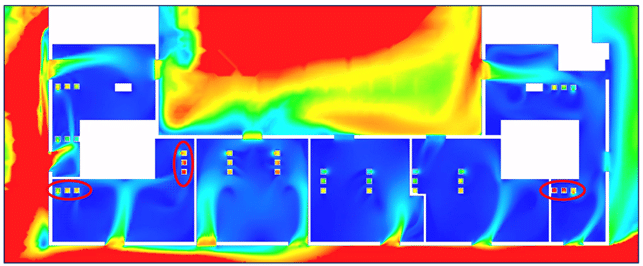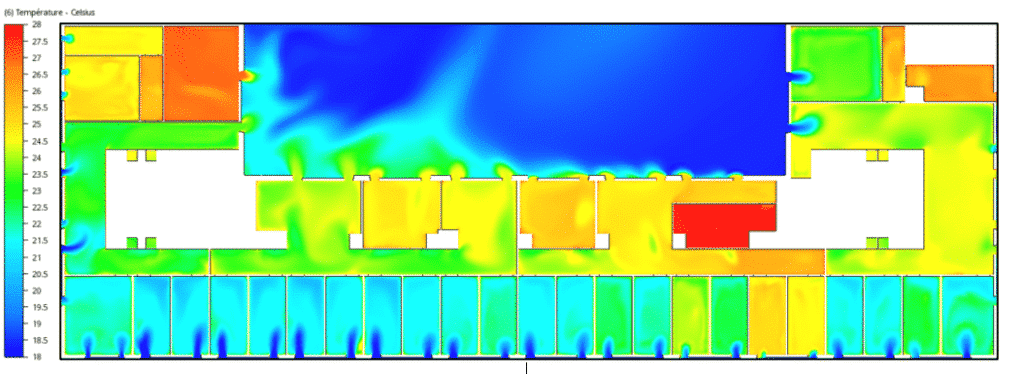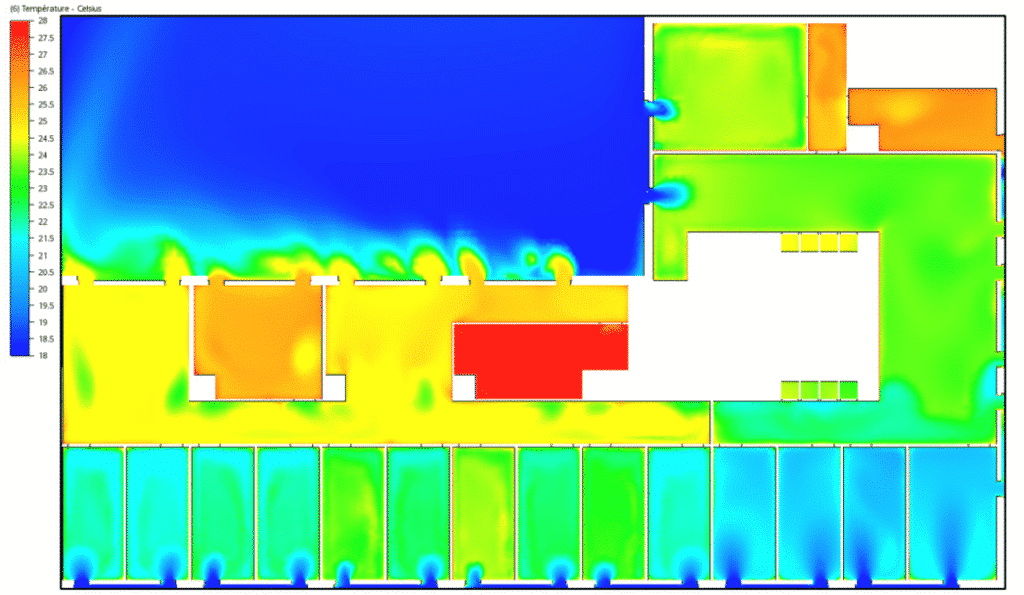Home » Prototype – Natural ventilation chimney
Prototype – Natural ventilation chimney
Project for a building ventilated by natural ventilation stacks
EOLIOS Ingénierie was contacted by an architectural firm to study the natural ventilation of a future building. The office premises were to be ventilated using wind chimneys. In this type of natural ventilation, it is not the effect of thermal draught that takes precedence, but the action of the wind.
In this study, EOLIOS studied several types of chimney and determined which offered the best airflow.
Prototype - Natural ventilation chimney
Year
2024
Customer
Location
Rennes
Typology
HVAC engineering
Continue navigation :
Our other projects :
Latest news :
Technical file :
Our expertise:
Numerical simulation of natural ventilation using a wind stack
Project overview
Eolios has carried out an in-depth study of a future architectural project that integrates two main components: a section dedicated to housing and another to business premises. Our focus is specifically on the latter, as it is the business premises that will benefit from a natural ventilation system.
Climate study
To carry out this natural ventilation study, we first carry out a climatic analysis of the future site, in order to make the simulations as realistic as possible. For this project, the climatic analysis revealed that the wind blows mainly from the south-west. A second dominant wind comes from the north-east. Having identified these dominant winds, we measure their intensity, i.e. the average wind speed in these directions, as well as minimum and maximum speeds to study extreme cases.
A seasonal temperature study has also been carried out, but is not presented in this section. In the remainder of this article, we will present results for a south-westerly wind speed of 6 m/s, which, according to this climatic study, is the most frequent wind.
3D model
When studying the natural ventilation of a building, it’s crucial to take into account neighboring buildings that act as aeraulic masks. These surrounding structures can have a significant impact on the airflow aroundand through the building under study. The presence of neighboring buildings can create zones of varying pressure and turbulence that influence wind direction and speed. Consequently, accurate modeling of these neighboring buildings is essential for a realistic assessment of natural ventilation.
By modeling neighboring buildings, we can simulate the effects of obstacles on air currents. This includes determining wind shadow zones, where air flow is reduced or disturbed, and wind channels, where flow is accelerated. These phenomena can affect the indoor air quality, thermal comfort and energy efficiency of the building under study. Good modeling helps identify the best positions for ventilation openings, such as windows and vents, to optimize the supply of fresh air and the removal of stale air.
Sizing
Correct sizing of ventilation ducts is essential for efficient ventilation. Eolios offers its expertise in sizing and improving natural ventilation systems. CFD simulation is then used to verify this sizing. The advantage of CFD lies in the possibility of testing several systems and configurations. Indeed, it is easier to modify ventilation systems during the simulation phase than when they are already installed.
Try out several CFD chimneys
Studies have been carried out on several chimneys:
- One with a rectangular conduit 4m high and a flat hood
- Two with a 4m-high cylindrical duct: one with a fixed half-spherical hood and the other with a rotating hood.
- And a 4m high façade with 2 orientations
The aim of the study is to determine the most appropriate shape for the project by comparing the flow rates extracted by the chimneys in the different configurations. Capture surfaces and flue sizes are equivalent for each study, in order to compare natural draft efficiency only.
Air velocities for 4 different chimney configurations
Studies show that the chimney with the rotating hood creates the most draft. Output is around twice that of fixed hood chimneys, irrespective of wind source or disturbance from surrounding buildings. What’s more, the hood rotates to provide optimum conditions for the best draft.
Façade-mounted chimneys can be an interesting solution, despite some constraints. Depending on the wind direction and the orientation of the chimney, it can operate either as an air inlet or an air outlet, which can be both an advantage and a drawback.
For the purposes of this study, in order to obtain the best possible draught, a chimney with a rotating hood is the preferred choice.
Simulations and results
This section presents the results of CFD simulations with individual ducts and movable cylindrical chimneys. Indeed, as initial simulations show, this type of chimney is the most efficient.
The simulation results presented below are for a south-westerly wind of around 6 m/s. This is the prevailing wind in the project area. It should be noted that other wind directions and speeds are tested, but are not presented in this article.
The red areas indicate which stacks are most affected by the south-westerly wind. Stacks that do not have these red spots are less affected by the wind, due to the presence of other stacks upstream.
Again with the aim of comparing fixed and mobile chimneys, two studies have been carried out for each case, and are presented below.
Velocity distribution in individual flues of mobile chimneys - Predimensioning study
At first glance, the velocities in the flues of mobile chimneys are higher than in the flues of fixed chimneys. There is also a difference between the flues of fixed chimneys. In the case of fixed chimneys, the chimney with the longest flue (1st floor) has a flow rate of 0.7 Vol/h, well below the 5 Vol/h expected. Only the shortest flue (5th floor) comes close to meeting the 5 Vol/h target, and this flow rate increases as you move upstairs.
The table below summarizes flow rates by floor and by chimney type:
This table shows that ventilation by fixed chimney works on average 2 times less well than ventilation by mobile chimney. It is also important to note that, with a fixed chimney, the second floor is virtually unventilated.
In this study, the facade openings studied are in the upper position and open once every two frames, as shown in the figure below.
It can be seen that the series of stacks directly exposed to the wind (circled in red on the figure above) have flow rates well above the average for other stacks. For these stacks, the 5 Vol/h target is therefore achieved in the mobile case, but not in the fixed case.
We can see from these initial results that natural ventilation functions correctly in the case of the chimney with the movable hood. In this case, the ducts have been correctly sized to achieve a ventilation rate of 5 Vol/h.
Simulation of night-time discharge using natural ventilation
Quantifying the benefits of natural stack ventilation
Following studies of the performance of different types of chimney, a study was carried out to assess the night-time discharge in this building thanks to natural ventilation and these chimneys. Night-time unloading is the passive cooling process that exploits the drop in outside temperatures during the night to evacuate heat accumulated during the day. This phenomenon is based on the natural or forced circulation of air, enabling indoor temperatures to be reduced andthermal comfort to be improved without the need for mechanical air conditioning.
This study aims to quantify theeffectiveness of this mechanism as a function of climatic conditions, building characteristics and induced air flows.
Night discharge condition
In order to model a night-time discharge corresponding to a realistic scenario, we chose to simulate a temperature difference of 10°C between indoor and outdoor air. More precisely, we considered two characteristic situations: an outside temperature of 18°C and an inside temperature of 28°C.
This choice is based on the assumption that, during periods of high heat, thermal accumulation within the building leads to a rise in interior temperature, while the drop in outside temperatures during the night initiates a passive cooling phenomenon. This temperature difference favors natural ventilation, creating a thermal gradient that allows air to circulate through the building’s chimneys and openings.
Wind conditions were also determined on the basis of the climatic study carried out previously. The majority wind on site was chosen for this study.
Results of climatic discharge studies
The results of the night-time discharge make iteasy to identify well-ventilated zones, where indoor temperatures are relatively close to the outdoor temperature. These zones benefit from efficient air mixing, which promotes passive cooling of the building.
Conversely, poorly ventilated areas are also highlighted. In these spaces, air circulation is more limited, resulting in high residual temperatures, close to 28°C. Identifying these zones is essential to optimize the natural ventilation strategy, by adjusting openings or integrating solutions to improve air renewal and homogenize temperature distribution.
The studyidentified hot spots in the building and analyzed their impact on thermal comfort. Overall, night-time discharge proved effective in maintaining comfortable temperatures throughout most of the building, promoting optimal passive cooling.
However, it can be seen that spaces with little traffic do not benefit from night-time unloading.
The study also played a key role inhelping our customeroptimize natural ventilation. Thanks to the results obtained, we were able to draw up a list of best practices for maximizing natural ventilation and, consequently,improving night-time relief. These recommendations include optimizing the management of openings, adjusting air flow rates, and taking full advantage of temperature differences to enhance theeffectiveness of passive cooling.
Continue on this topic
Video summary of the study
Video summary of the study
Discover other projects
Study of aeraulic comfort – Middle school
Wind comfort study – Rooftop
Wind impacts on high-rise buildings: Tours Olympiades in Paris
Comfort – Rooftop of a palace – Casablanca
Tour Liberté – La Défense
Impact of wind on a solar power plant
Cooling towers – ICPE
Pedestrian comfort study – La Défense
Confort au Vent – PSG training center
Wind study – La Défense
Fine particle capture in a metro station
Sharaan by Jean Nouvel resort
Air coolers – Critical study – Heat wave
Fine dust measurements
Balenciaga – Wind potential

